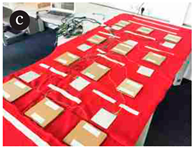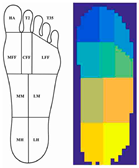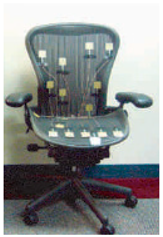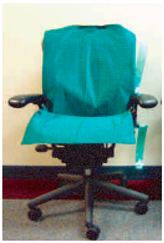Abstract
Force-based human posture estimation (FPE) provides a valuable alternative when camera-based human motion capturing is impractical. It offers new opportunities for sensor integration in smart products for patient monitoring, ergonomic optimization and sports science. Due to the interdisciplinary research on the topic, an overview of existing methods and the required expertise for their utilization is lacking. This paper presents a systematic review by the PRISMA 2020 review process. In total, 82 studies are selected (59 machine learning (ML)-based and 23 digital human model (DHM)-based posture estimation methods). The ML-based methods use input data from hardware sensors—mostly pressure mapping sensors—and trained ML models for estimating human posture. The ML-based human posture estimation algorithms mostly reach an accuracy above 90%. DHMs, which represent the structure and kinematics of the human body, adjust posture to minimize physical stress. The required expert knowledge for the utilization of these methods and their resulting benefits are analyzed and discussed. DHM-based methods have shown their general applicability without the need for application-specific training but require expertise in human physiology. ML-based methods can be used with less domain-specific expertise, but an application-specific training of these models is necessary.
1. Introduction
Human posture estimation is an essential method for data acquisition in many applications, including the fields of sports science, ergonomics, rehabilitation and user-centered product design [1,2,3,4,5,6]. Traditionally, camera-based motion capture systems have been used for human motion capturing and posture estimation [7,8]. Camera-based systems, especially marker-based systems, offer high precision but are limited by the need for external measurement equipment such as cameras, leading to a restricted measurement space and significant preparation effort [9,10]. However, in recent years, non-camera-based sensors have also emerged as valuable alternatives for human posture estimation [11,12,13]. Non-camera-based sensors can offer advantages in terms of flexibility and portability as well as cost-efficiency [14,15,16].
Common alternatives to camera-based methods include the use of data from inertial measurement units (IMUs), electromyography (EMG), and pressure or force sensors [17,18,19]. The sensors for measuring these data do not need to be set up externally to observe the subject. They can be worn directly on the human body or be integrated into smart products like smartwatches, phones, or even sensor-integrated devices such as exoskeletons or smart seats [17,20,21,22,23]. While estimating human posture using IMU sensors for dynamic motion has been well investigated and is used in some commercial motion-capturing systems for sports analyses and the film industry, this technology has limitations when capturing static postures [20,24]. For static postures, such as lying in a bed, sitting on a chair or standing in the same position for a long period of time while working, the displacement of the measurement data is small. Thus, the drift of the sensors has a large impact on the accuracy of the posture estimation [25].
New approaches investigate the application of force and pressure data from pressure and force sensors or as a virtual force vector in simulations to estimate human posture in static applications. Since the first approaches were published in the early 2000s through the dissemination of machine learning algorithms (ML) and digital human models (DHM), research in this area is relatively new. As a result, many models and methods for force-based human posture estimation has emerged in various research disciplines. However, there is currently a lack of a comprehensive overview of these methods, as well as criteria for selecting the most suitable models and methods for specific applications. Such an overview is necessary to fully exploit the potential of this technology and to guide further research in this area. To address this gap, this systematic literature review aims to summarize the existing models and methods in the literature and answer the following research questions:
- What are the existing input data sources and estimation methods used in studies to estimate human posture based on force data and pressure maps?
- Which human posture estimation methods are used for which types of application scenarios, and what previous expert knowledge is required for their use?
2. Human Posture Estimation
Human posture estimation, the process of determining the spatial configuration of the human body, has diverse applications across various domains, e.g., computer vision, sports analyses, biomechanical research, security, and surveillance. It involves identifying the positions and orientations of body parts, typically using visual or sensor data. The term “human posture estimation” or “human pose estimation” is most commonly known by camara-based computer vision applications [26,27], as shown in Figure 1. In computer vision, it is crucial for tasks like gesture recognition and human–computer interaction by the identification of the human joint positions or body shapes from rgb or depth images [28]. However, human posture estimation is not limited to cameras, as described so far.

Figure 1.
A general schemata for the data processing of human posture estimation in computer vision on 2D rgb images (right hand side) and examples of identified human postures in diverse activity contexts (left hand side) described in a graphical abstract by Ben Gamra and Akhloufi [26] (Reprinted with permission from [26], 2023 Elsevier).
In the following literature review, the term “human posture estimation” is generally used for refer to the detection of human posture (joint angles, sitting positions, sleeping positions, etc.) from a measured data set. Examples of slouch detection and sleeping posture are shown in Figure 2. In the case of our literature review, the data on which the estimation is based are limited to pressure maps and force vectors. We also included studies from the representative literature for the review that use activity recognition and re-infer the most probable posture. This method can be applied if the activity is dominated by instinctive movements like gait activities and is not influenced by external boundary conditions, like in the case of a working posture. It is unique for a certain task and working environment.

Figure 2.
Different human postures that are estimated based on force data in representative studies in the literature review. (a) Human sitting postures classified by pressure data from a sensor on top of a chair [29]; (b) Sleeping postures that can estimated using ML-based algorithms [13] (Reprinted with permission from [13,29], 2023 Springer Nature).
3. Materials and Methods
This systematic review follows the criteria of the “Preferred Reporting Items for Systematic Reviews and Meta-Analyses (PRISMA 2020)” statement [30,31]. The steps of the review process according to PRISMA 2020 are illustrated in Figure 3.
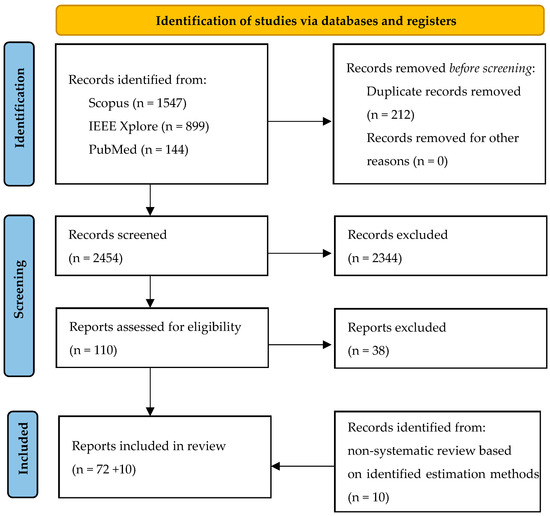
Figure 3.
Flowchart of the review process according to PRISMA 2020 [30].
3.1. Information Sources and Searching Strategy
This systematic literature review is performed on publications between 2000 and 2022 using the databases of Scopus, IEEE Xplore and PubMed. A versatile string is used for the review due to differences in the declaration of the methods. Combining synonyms of the five major terms “human”, “posture”, “estimation”, “force”, and “method” (Table 1) leads to the following string: TITLE-ABS-KEY (human AND (posture OR pose) AND (prediction OR estimation OR classification OR recognition) AND (force* OR pressure OR load OR weight) AND (model* OR method*)). To limit the results to non-camera-based methods and exclude studies on human blood pressure, the following keywords are used: “rgb”, “video”, “*vision*”, “*cular”, “*blood*” and “*birth*”. Further, the results are limited to the subareas “medicine”, “engineering”, “computer science”, “health professions”, “multidisciplinary” and “nursing”. Other subareas are checked by random samples and excluded due to their lack of relevance. The language is limited to English.

Table 1.
Clustered keywords selected as search string for this literature review.
3.2. Screening Process
Searching in both databases resulted in a total of 1365 papers. To select the relevant ones, the papers are summarized by title, author and abstract in a spreadsheet using EXCEL 2019 (Microsoft Corporation, Redmond, WA, USA). The following exclusion criteria are defined for screening the primary results by title and abstract:
- The minimum required input for posture estimation includes data from at least one force sensor, pressure mat or virtual force vector.
- The output of the estimation includes the human posture, e.g., whole-body postures or one or more joint angles.
- Additional sensor inputs are allowed, except human motion data from classical motion capture systems. Classical motion capture systems are only allowed for the evaluation of the results.
Non-relevant papers are excluded from further steps. After selecting the relevant papers by title and abstract, the full text reports of the remaining papers are manually screened again during the data analysis. No automated tools are used for the screening process. The literature is managed using the software CITAVI 6 (Swiss Academic Software GmbH, Wädenswil, Switzerland). As a result, a total of 72 papers, each representing a distinct study, are selected for further data analysis.
3.3. Additional Reports with Non-Standardized Terminology
Due to the use of inconsistent terminology in describing ML-based and DHM-based methods, 10 additional papers on force-based human posture estimation are included after the screening process. This non-systematic literature review is based on the main methods, models and applications that are identified by analyzing the results of the structured literature review. A valuable input for additional relevant papers is provided by a systematic literature review by Ngueleu et al. [32]. This review also covers some methods of force-based human posture estimation from insole pressure data, but the main focus in this review is on insole force sensors and methods for step-counting. Additional papers are also approved using the criteria of the screening process and are marked with an asterisk in the table. The reasons for the decision to add these papers are reflected further in the discussion.
3.4. Data Analysis
To answer the research questions, information about the following main categories is extracted from each paper, as far as possible.
- Input Data Source:The input data source describes the origin of the sensor data or virtual force vector input information used for posture estimation.
- Estimation Method:The estimation method describes the method used to estimate human posture to give an overview of the most relevant methods.
- Application ScenarioThe application describes the scientific domain in which the study was conducted as well as the specific activities the participants performed in the studies.
Two large tables—one for ML-based posture estimation methods and one for DHM-based posture estimation methods—list all the information that is extracted for each paper in detail. To sum up all the information, the findings of the review are described for the main categories.
The required expertise and previous knowledge about the application context needed for using the methods cannot be quantified statistically from the review. Therefore, the results contain sections summarizing the estimation methods, input data sources and applications that form the basis of this review. The discussion section of this paper explores how the required expertise and knowledge about the application context affect the use of these methods in various domains, as elaborated by the authors.
A statistical evaluation of the results is presented using a Sankey diagram, which illustrates the relationship between the methods, models and corresponding data types used for human posture estimation. The Sankey diagram is created using the online tool SankeyMATIC (www.sankeymatic.com, Steve Bogart, accessed on 24 October 2023). Additionally, the diagram highlights the most commonly applied methods and models in different domains. To assess the novelty and current relevance of the methods found, the number of publications per year is plotted, with different colors representing the ML and DHM approaches in the period from 2000 to 2022. Therefore, the Software IBM SPSS Statistics Version 28.0. (IBM Corp. in Armonk, NY, USA) is used.
4. Results
The main results of our literature review are summarized, focusing on the main categories we aimed to analyze. Thereafter, a statistical evaluation of the results is shown.
4.1. Input Data Sources and Sensors
The following summary is clustered into three sections. The first section covers the measurement principles that are used in the representative studies to record the data for posture estimation. Afterwards, the next section is about the sensor layouts of the hardware sensors before the difference between commercial and self-designed sensors is reflected.
4.1.1. Measurement Principles
The first screening criterion requires force or pressure data from hardware sensors or virtual force vectors as the main input parameters for human posture estimation. The sandwich structure of film pressure sensors consists of a top and bottom copper layer connected by a piezoresistive material (see Figure 4) [33].

Figure 4.
Sandwich structures of film pressure sensors consisting of a top and bottom copper layer connected by a piezoresistive ink: (left side) single-point sensor and (right side) sensor matrix [33] (Reprinted with permission from [33], 2023 Springer Nature).
The most commonly applied hardware sensors are thin film sensors that measure piezoresistive [13,16,34,35] or capacitive principles [15]. The sandwich structure of piezoresistive sensors consists of a top and bottom copper layer connected by a piezoresistive material (see Figure 4) [33]. Physical stress reduces the electrical resistance of the piezoresistive material and can be detected by an electronical measurement unit connected to the copper layers. The measurement principle allows a sensor thickness of up to 200 µm (FlexiForce A301, Tekscan Inc., Boston, MA, USA) and high flexibility. Capacitive sensors are filled with a non-conductive dielectric between the copper layers. Physical stress reduces the electrical capacity between both layers. Both measurement principles offer a similar measurement accuracy [36].
Additionally, load cells are also used in some studies to measure input data for posture estimation. Load cells differ in functionality and geometry from film pressure sensors. They typically use strain gauges or piezoelectric sensors and are not as thin as film sensors. Some load cells are capable of measuring more than just the force oriented perpendicular to the sensor. They also are capable of measuring forces in multiple directions and sometimes torques acting on the sensor. [37] Load cells are often more accurate than film pressure sensors. However, they tend to be more expensive and challenging in terms of the technical requirements for system integration [38].
Virtual force vectors are based on experience and knowledge about the application scenario. It requires a high expertise to define valid virtual sensors. They are found mostly in simulation studies.
4.1.2. Sensor Layout
The main difference that could be analyzed in the sensor layout is the difference between single-point film sensors, which can only measure the force or pressure value at one certain spot. The layout for load cells is comparable to the layout of single-point film sensors; also, they can partially measure the force in more than one dimension. The benefit of sensor matrixes is their ability to measure the force at multiple positions over a surface. On the other hand, the acquisition technology is more complicated for matrix sensors than for single-point sensors. Figure 4 shows the differences in the structure of a piezo-resistive single-point sensor and a piezo-resistive matrix sensor.
The selected sensor also influences the layout and positioning of the sensors in the application. The matrix sensors can mostly cover the entire relevant surface for pressure mapping. Single-point sensors have to be placed on the right spots to obtain all the relevant pressure information. Therefore, high expertise in the application is needed. Examples of different sensor layouts are given in Table 2.

Table 2.
Examples of sensor layouts for measuring the contact forces for force-based human posture estimation in different application scenarios.
4.1.3. Commercial Hardware Sensors and Self-Designed Hardware Sensors
The commercial hardware sensors used in the reviewed studies are mostly developed for laboratory studies and are distributed by official partners. This allows other researchers to obtain the same equipment to replicate the study setup, reproduce the study and compare their results with it. Thus, the measurement quality of these sensors is standardized, which improves the comparability of the results. However, the sensors and additional measurement equipment can be quite expensive.
Self-designed sensors allow more individual adaptions through integration into products instead of commercial hardware sensors [42,43,44,45,46]. All the reviewed, self-designed sensors are film pressure sensors. They are mostly made of a pressure-sensitive film known by the brand names VELOSTAT (3M Company, St. Paul, MN, USA) and LINQSTAT (CAPLINQ Corporation, Ottawa, ON, Canada). Alternatives are offered by Matthies et al. [15], who developed their own capacitive sensors for a smart mattress, and by Milovic et al. [43], with their research on textile sensors, as shown in Figure 5.
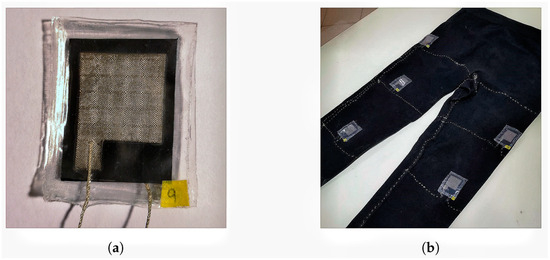
Figure 5.
(a) Sample of the textile pressure sensors self-manufactured by [43].; (b) textile pressure sensors attached to expandable fabric pants [43] (Reprinted with permission from [43], 2023 MDP).
4.2. Methods and Models for Human Posture Estimation
Human posture estimation methods can be divided into ML-based methods and DHM-based methods. ML-based methods work with only statistics, while DHM-based methods involve a lot of expert knowledge about the kinematics and dynamics of the human body.
4.2.1. Machine Learning Methods
In the reviewed papers, the performance and resource efficiency of different ML algorithms are compared under different constrains.
A general statement on the suitability of the algorithms for classification is not possible due to the different assumptions and constraints in the studies, as well as the lack of comparative values across studies. An overview of the most of used classification algorithms is given in Table 3. The resulting quality of the output data ranges from the simpler identification of body segments on a sensor mattress [13,47,48], to the assignment of predefined movement activities, to the classification of individual gait cycle phases directly related to leg joint angles during walking [43]. By using classification, only certain previously selected human postures can be recognized. These methods are well suited, e.g., to identify a critical situation during patient monitoring or analyze everyday activities. The continuous motion of a joint angle is not estimated using classification algorithms. Regression algorithms can also be used to estimate continuous joint angle motions. The regression model links the distribution and intensity of interaction forces in different situations to joint angles. Choffin et al. [12] use a K-nearest neighbor algorithm (kNN) and Clever et al. [49] use a convolutional neural network for posture estimation to obtain the continuous progress of a joint angle motion. Unlike other studies within this review, Rihar et al. [48] use an image recognition algorithm to evaluate the pressure map of a film sensor matrix to identify the different segments of a human body in a sleeping position. Image recognition is commonly used in AI applications. However, it is not popular for human posture estimation based on interaction forces.

Table 3.
Overview of the most often studied classification algorithms for force-based human posture estimation.
The classification accuracies reach values above 90% for the most used algorithms (see Table 3). Data pre-processing is used in most of the studies to improve the quality of the data input to the algorithms. Filtering, e.g., using Gaussian filters or the sliding window effect, is used to reduce the noise in raw data. Different recording frequencies of sensors are also equalized, and sensors values can be fused, e.g., when defining measurement areas on a matrix in the pre-processing step.
Feature extraction and data pre-processing influence the time and resource efficiency and the accuracy of ML-based human posture estimation. The selection of feature extraction methods is contingent upon the sensor type and application scenario considerations of the different studies, e.g.,
- Center of pressure determination;
- Histogram of Oriented Gradients (HOG) analysis;
- Sliding window techniques;
Some studies embrace convolutional neural network (CNN), which obviate intricate, hand-crafted feature extraction. The most representative feature extraction methods are also listed in Table 3.
4.2.2. Digital Human Models
DHM-based human posture estimation uses, unlike ML-based methods, knowledge of the kinematics and dynamics of the human body to extrapolate a human posture from force or pressure data. The DHMs used in the reviewed studies can be divided into two main categories. The first category consists of basic kinematic and dynamic models that focus on separating the segments of the human body. On the other hand, there are more complex and widely used DHMs that are commercially available or open-source and are often recognizable by their brand names. Based on the thermology of Demirel et al. [75], the latter ones can be further categorized into DHMs for 3D CAD and modeling and DHMs built as a finite element or multibody dynamics simulation. In most cases, posture estimation is realized by optimizing the joint angles to minimize a certain criterion, e.g., muscle activity or joint torques. An overview of the optimization criteria is given in Table 4:

Table 4.
Overview of the optimization criteria for DHM-based human posture estimation.
Simple dynamic models are usually represented by rigid elements and joints with different degrees of freedom without spring or damper properties. An evaluation of these dynamic models is conducted via an inverse kinematic analysis. A typical dynamic model that is used for the posture estimation of a weightlifting sportsperson by Rahmati and Mallakzadeh [78] is visualized in Figure 6.
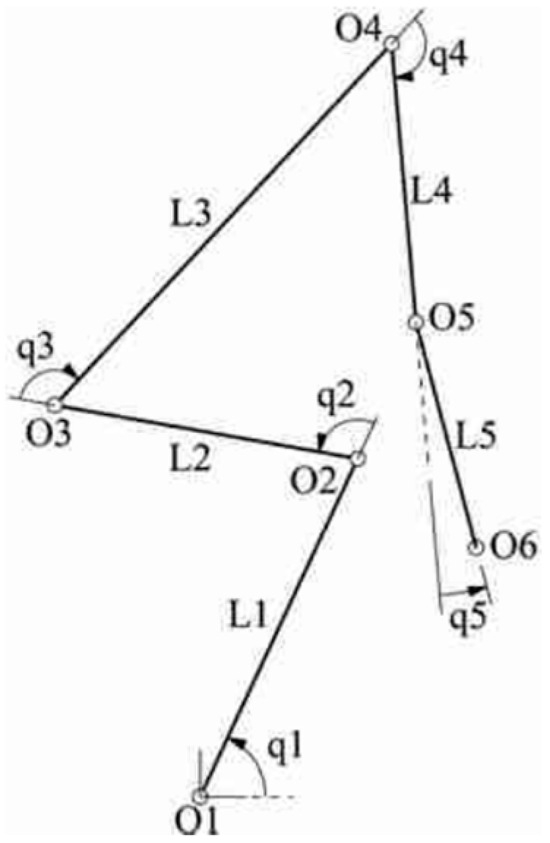
Figure 6.
Visualization of the dynamic digital human model used by Rahmati and Mallakzadeh [78] for the posture estimation of a weightlifting sportsperson. (Reprinted with permission from [78], 2023 Elsevier B.V.)
Some of the studies use DHMs that were originally developed for early validation during the design process of ergonomic workshops and automotive cockpits. Thus, the concept of these models is a combination of a rigid dynamic model of the human body and a body shape model to provide a realistic impression of how humans can move inside the application environment [83]. In the reviewed studies, the SANTOS model (SantosHuman Inc., Coralville, IA, USA) is mainly used to perform inverse kinematic analyses [77,84,85]. Its evaluation is similar to that of simple kinematic models but is supported by the user interface and a realistic representation of the human body. The JACK model (Siemens Industry Software Inc., Plano, TX, USA) [86], the RAMSIS model (Human Solutions GmbH, Kaiserslautern, Germany) [87,88] and the 3DSSPP model (VelocityEHS Inc., Chicago, IL, USA) [89] are used as dynamic models similar to the SANTOS model [88], but also as body shape models, e.g., to calculate the contact surface between the human and a pressure-sensing object. A use case for the RAMIS DHM is shown in Figure 7.
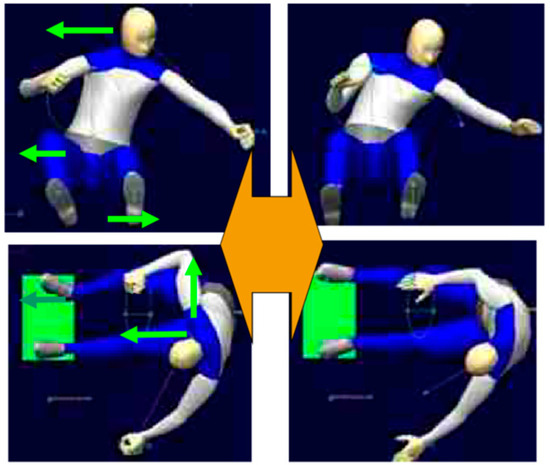
Figure 7.
Using the RAMIS DHM for estimating the drivers posture closing a car door (left: force-based estimated posture, right: video-recorded real posture, green arrows displays the external forces for the FPE) [90].
The DHMs in the “finite elements and multibody dynamics DHM” category represent the structure and the interaction of the human body in the most detailed, but also most complex, way. The studies for human posture estimation are dominate by the use of musculoskeletal models. Musculoskeletal models are multibody dynamic simulations built up from the bones of the human skeleton as rigid bodies and the muscles as dynamic connections. In many studies, the commercial software AnyBody (AnyBody Technology A/S, Aalorg, Denmark) is used to calculate muscle activity and optimize the body posture for minimal muscle activity [79].
4.3. Application Scenarios
Human posture estimation based on interaction forces serves as an automated alternative when traditional camera-based posture estimation is infeasible or more costly to install. This is particularly useful in scenarios where camera installation may limit mobility or when the use case involves a virtual posture estimation. In such cases, the main input condition is the impact of an external force on the human body. The main application domains of the studies investigated are healthcare—especially for patient monitoring—[13,22,35,39,46,47,48,61,64,71], sleep research [45,49,91,92,93], sports science [37,76,94], product [84] and automotive design [34,87,88] and the sub-domains of ergonomics—industrial ergonomics [12,50,77,80,82,86,89,95,96], gait analyses [43,51,65,85,97] and sitting ergonomics [14,16,21,44,54,69,72,98,99,100,101]. The context of the application scenarios also influences the estimation methods that are best to use for the posture estimation. For example, the application scenario can limit the training data that can be generated for the ML-based methods. Further, the application scenarios also influence what kind of sensor can be used and where it should be placed to measure the force data.
4.4. Findings
The findings and results from the reviewed papers can be categorized into several areas, including the design and integration of sensor hardware into products for specific applications, testing the performance of new ML algorithms for posture estimation and comparing them, applying and testing validated ML algorithms for new applications and input data and improving existing DHMs for human posture estimation. Figure 8 shows the result of lower-body posture estimation nearly fitting perfectly to the ground truth data.
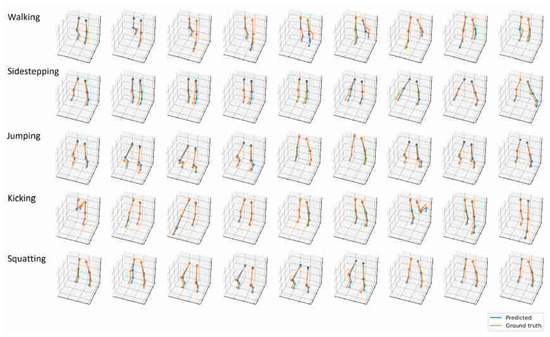
Figure 8.
Comparison of estimated lower-body motion and a motion-captured ground truth [102] (Reprinted with permission from [102], 2023 IEEE Xplore).
4.5. Sankey Diagram
The Sankey diagram (Figure 9) shows the connections between the input data sources, the estimation methods and the application scenarios for which the estimation methods are used. It also shows the percentage of times each data source, method, and application are used in the reviewed studies. When dividing studies into those with ML-based methods and DHM-based methods, the classification algorithms favor ML-based estimation methods, while the basic dynamic human models favor the DHM-based estimation methods. Furthermore, film pressure sensor matrices and single-point film pressure sensors are the main input data sources for the classification, and virtual force vectors are mainly used as input for DHM-based posture estimation. The utilization of the different methods is evenly distributed among the different applications. Only in the healthcare domain—especially for patient monitoring—classification algorithms dominate. The main applications are patient monitoring in the healthcare domain and product optimization in various subdomains of ergonomics.
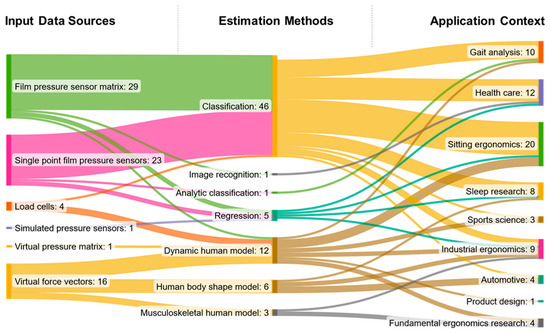
Figure 9.
Sankey diagram showing the relations between input data sources, estimation methods and applications, including the number of studies found.
4.6. The Novelty and Relevance of Human Posture Estimation
The histogram in Figure 10 shows the emergence of DHM-based methods for human posture estimation, with the investigation of these methods starting in the early 2000s. There has been a notable increase in the number of publications on ML-based methods since 2007, indicating a growing interest in recent years. In contrast, the number of publications on DHM-based methods has remained relatively constant over the years.
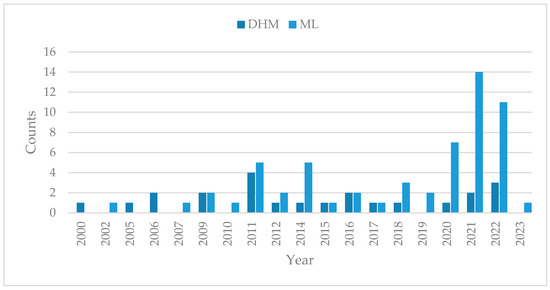
Figure 10.
Histogram of published studies on force-based human posture estimation, divided into machine learning (ML)-based estimation methods and digital human model (DHM)-based estimation methods, over the years.
Datailed Information about the Analysed Studies
A detailed analysis of the representative studies serves as the basis for the summarized findings below and is presented in the following tables. Within Table 5, the data includes input data sources, estimation algorithms, performance evaluations, data preprocessing and feature extraction, and application scenarios derived from studies using machine learning-based methods. Meanwhile, Table 6 presents information from studies using digital human models (DHMs), including details on input data sources, the specific DHM, optimization criteria, and application scenarios.

Table 5.
Summary of relevant studies for ML-based human posture estimation and the analysis of the used input data sources, estimation algorithms, acquired accuracy, data pre-processing/feature extraction and application scenarios (* marks the extra-added reports after the structured literature review); the best performing estimation algorithm for each study is highlighted bold.

Table 6.
Summary of relevant studies for DHM-based human posture estimation and the analysis of the used input data sources, digital human model, optimization criterium, and application scenarios (* marks the extra added reports, after the structured literature review).
5. Discussion
As motivated in the beginning, the research on human posture estimation based on interaction forces is characterized by a high level of interdisciplinarity extending from computer science and sensor development to product design, ergonomics and health care. This interdisciplinarity challenges researchers to obtain an easy overview from the literature of the existing methods and models and the boundary conditions for their application. To close this knowledge gap and support the utilization of the methods of human posture estimation based on interaction forces, the research questions of this systematic literature review are divided into two:
- Extracting the used input data sources and estimation methods from the literature.
- Evaluating the types of application scenarios and previous expert knowledge used in the reviewed studies.
The first aspect can be answered through a data analysis of the review’s results, as illustrated by the Sankey diagram in Figure 8. Summarizing the results, the main methods for human posture estimation are classification algorithms when ML-based methods are used and inverse kinematic analyses of simple dynamic models when DHM-based methods are used.
Classification algorithms mainly use input data from thin-film pressure sensors, which offer advantages such as flexibility and seamless integration into existing products. On the other hand, DHM methods use virtual force vectors, which require a comprehensive understanding of the use case. Nevertheless, the final results should be validated by an experimental study. Such validation is conducted in the studies by Davoudabadi Farahani et al. [79] and Mao et al. [99].
The second aspect of the research questions cannot be answered only by an analysis of the review data. A specific interpretation of the application scenarios is necessary. Additionally, the histogram is helpful for understanding the necessary previous expert knowledge. The main findings of our systematic literature review are illustrated in Table 7 and discussed in the following to support researchers in selecting the best methods and input data sources for their application.

Table 7.
Summary and qualitative ranking of the main estimation methods and main input data sources for force-based human posture estimation identified in the structured literature review.
With the advent of AI research and standard ML algorithms for common applications of data processing, ML algorithms are also used for force-based human posture estimation. The principles of the ML-based methods can be understood as a virtual sensor [112]. They use data from hardware sensors, mostly force or pressure sensors, and apply previously trained ML models to estimate human posture. These algorithms provide established frameworks, efficient computations and well-documented methodologies, making them suitable for a wide range of applications. Many studies in the literature compare the efficiency and resulting quality of different ML algorithms for classification. Due to the divergent conditions in the studies, in an evaluation, the best algorithm for human posture estimation based on interaction forces is not obvious. The most often used algorithms are CNN, kNN, SVM, RF, and NB algorithms. Data processing using ML algorithms does not require specific knowledge about the physiology of the human body. Although more advanced techniques and algorithms are being developed, the use of standard algorithms remains a practical choice due to their ease of implementation, computational efficiency and performance. When using ML algorithms, the training data are obtained from hardware sensors, which record data during experimental studies similar to the situations in which human posture should be estimated. This required more effort for the adaptation of these methods to a new application than in the simulation environment of a DHM. Due to the need for sensor data as the input for the ML algorithms, research on hardware sensors and their integration into everyday products becomes increasingly important. It also demonstrates a chance to apply ML-based methods for automated utilization in sensor-integrated products. In the current state of research, the majority of published studies focus on classification algorithms with relatively simple class definitions. These are mostly various movement activities or specific phases of a gait cycle. However, there are few works that use ML algorithms to continuously estimate one or more human joint angles. Further research is needed on this topic to provide an established procedure for the utilization of regression algorithms for human posture estimation based on interaction forces.
The use of DHMs began in the early 2000s and forms the baseline for FPE [88]. Most often, muscle activation and joint forces are computed to analyze the physical stress of a human subject. Reversing this idea, DHM-based posture estimation optimizes physical stress by adjusting human posture. The valid application of these DHM-based methods requires specific expert know-how about the physiology of the human body in the form of a DHM and comprehensive knowledge about boundary conditions and external influences on humans for the specific use cases. As a result, only experts who are very familiar with DHMs can use them properly. These experts come from the fields of ergonomics and medical research. Simulation-based posture estimation offers several advantages, including its applicability to non-physical existing scenarios and the ease of adapting human model properties or external influences. Also, these methods eliminate the need for conducting physical experiments, resulting in faster and more cost-effective processes. However, an online posture estimation is not known to exist in the literature so far. Due to the highly required expertise for the utilization of DHMs and the expert knowledge needed for their application, an online estimation process and product integration are not expected soon.
As mentioned in the methods for the review process, a challenge we encountered was the lack of consistent terminology used in the research community for human posture estimation based on interaction forces. To address this issue, we clustered different synonymous keywords for the search string. Nevertheless, not all papers involving human posture estimation based on interaction forces can be covered by this literature research. In particular, studies using DHMs are difficult to find without searching for the specific DHM method names, although some were added manually based on the authors’ knowledge. We prioritized the dominating keywords “posture” and “estimation” for the terminology of the review paper. To gain a more comprehensive understanding, it is helpful to search for similar review papers, e.g., on motion capture in general [9] or the various specifications and applications of DHMs [75]. In this way, it is possible to find publications using alternative terminologies. However, methods for force-based human posture estimation are not the focus of these papers. Thus, it is left to the reader to compare the different methods and evaluate their suitability by themselves.
Due to this inconsistent use of terminology, there is no suitable search string that identifies all known papers on studies of FPE. Therefore, we decided to include the papers we were aware of from previous searches in the results. While this approach differs from a classical structured literature review, we chose it in order to get closer to a complete overview of the published methods.
6. Conclusions
This systematic literature review, according to PRISMA 2020 [30], provides an overview of the relevant estimation methods, dominated by classification algorithms and the posture optimization of digital dynamic human models. As a guideline for the existing methods, the required expertise and information on the application context are extracted from the reviewed studies. The data used for the posture estimation come from experimental studies using thin flexible film pressure sensors, and in virtual simulations, from force vectors. The required expertise for the utilization of a method and the know-how about the application context tend to increase the resultant benefits, as illustrated in Table 7. DMH-based methods can be performed in virtual simulations without relying on experimental studies, but they require a more specific understanding to build and apply the models specific to the use case. On the other hand, conventional ML methods can be used to estimate activity classes or human posture when sufficient experimental training data are available, with less need for expert knowledge. As part of the ongoing research in this area, it is worth noting that the review has highlighted the remarkable performance achieved by classification algorithms. However, the inherent limitation of classifying a predefined set of postures has become apparent. To bridge the gap and achieve results on par with established methods such as camera-based posture estimation and IMU sensors, the use of regression algorithms becomes imperative. Interestingly, a small number of studies have ventured into this area, investigating joint angles in gait analysis and upper body alignment during sitting. These initial forays offer a promising glimpse into the potential of regression algorithms in posture assessment. However, it is clear that more extensive research is needed to thoroughly explore and validate the utility of such approaches.
Furthermore, an evaluation of the application scenarios and previous expert knowledge was conducted based on the results of the review to further assist researchers in the selection of the best estimation methods and input data sources for their application. The evaluation of the application context showed that ML-based methods consistently perform well in tasks such as sleep and sitting position recognition, as well as gait analysis. However, DHMs are preferred for manual tasks. There is a noticeable gap in research regarding the potential suitability of ML-based applications for posture assessment in manual tasks. Further research in this area is warranted to explore its feasibility. The review also has some limitations, including the non-standardized terminology of the keywords and the inclusion of studies focusing on activity recognition, which may not necessarily count towards posture estimation.
Author Contributions
The conceptualization part for this manuscript was carried out by S.H. and S.M. together. Both the literature review and data analysis processes, as well as the preparation of the manuscript, were performed by S.H. and S.M. carried out the scientific supervision of the project. All authors have read and agreed to the published version of the manuscript.
Funding
This manuscript was prepared as part of the JuBot project, which is funded by the Carl Zeiss Foundation.
Data Availability Statement
All data generated are included in this study.
Acknowledgments
We acknowledge support from the KIT-Publication Fund of the Karlsruhe Institute of Technology and Lisa Sackenreuther, student assistant, for her help in obtaining a primary first impression of the literature.
Conflicts of Interest
The authors declare no conflict of interest. The funders had no role in the design of the study; in the collection, analyses, or interpretation of data; in the writing of the manuscript; or in the decision to publish the results.
References
- Hreljac, A. Stride smoothness evaluation of runners and other athletes. Gait Posture 2000, 11, 199–206. [Google Scholar] [CrossRef]
- Ganzevles, S.P.M.; Beek, P.J.; Daanen, H.A.M.; Coolen, B.M.A.; Truijens, M.J. Differences in swimming smoothness between elite and non-elite swimmers. Sports Biomech. 2023, 22, 675–688. [Google Scholar] [CrossRef]
- Asfour, T.; Dillmann, R. Human-like motion of a humanoid robot arm based on a closed-form solution of the inverse kinematics problem. In Proceedings of the 2003 IEEE/RSJ International Conference on Intelligent Robots and Systems (IROS 2003) (Cat. No.03CH37453), Las Vegas, NV, USA, 27–31 October 2003; pp. 1407–1412, ISBN 0-7803-7860-1. [Google Scholar]
- Beil, J.; Ehrenberger, I.; Scherer, C.; Mandery, C.; Asfour, T. Human Motion Classification Based on Multi-Modal Sensor Data for Lower Limb Exoskeletons. In Proceedings of the 2018 IEEE/RSJ International Conference on Intelligent Robots and Systems (IROS), Madrid, Spain, 1–5 October 2018; pp. 5431–5436, ISBN 978-1-5386-8094-0. [Google Scholar]
- Sänger, J.; Yao, Z.; Schubert, T.; Wolf, A.; Molz, C.; Miehling, J.; Wartzack, S.; Gwosch, T.; Matthiesen, S.; Weidner, R. Evaluation of Active Shoulder Exoskeleton Support to Deduce Application-Oriented Optimization Potentials for Overhead Work. Appl. Sci. 2022, 12, 10805. [Google Scholar] [CrossRef]
- Möhler, F.; Fadillioglu, C.; Stein, T. Fatigue-Related Changes in Spatiotemporal Parameters, Joint Kinematics and Leg Stiffness in Expert Runners During a Middle-Distance Run. Front. Sports Act. Living 2021, 3, 634258. [Google Scholar] [CrossRef] [PubMed]
- Shotton, J.; Fitzgibbon, A.; Cook, M.; Sharp, T.; Finocchio, M.; Moore, R.; Kipman, A.; Blake, A. Real-time human pose recognition in parts from single depth images. In Proceedings of the 2011 IEEE Conference on Computer Vision and Pattern Recognition (CVPR), Colorado Springs, CO, USA, 20–25 June 2011; Staff, I., Ed.; IEEE: New York, NY, USA, 2011; pp. 1297–1304, ISBN 978-1-4577-0394-2. [Google Scholar]
- Sarafianos, N.; Boteanu, B.; Ionescu, B.; Kakadiaris, I.A. 3D Human pose estimation: A review of the literature and analysis of covariates. Comput. Vis. Image Underst. 2016, 152, 1–20. [Google Scholar] [CrossRef]
- van der Kruk, E.; Reijne, M.M. Accuracy of human motion capture systems for sport applications; state-of-the-art review. Eur. J. Sport Sci. 2018, 18, 806–819. [Google Scholar] [CrossRef] [PubMed]
- Pfister, A.; West, A.M.; Bronner, S.; Noah, J.A. Comparative abilities of Microsoft Kinect and Vicon 3D motion capture for gait analysis. J. Med. Eng. Technol. 2014, 38, 274–280. [Google Scholar] [CrossRef] [PubMed]
- Valero, E.; Sivanathan, A.; Bosché, F.; Abdel-Wahab, M. Analysis of construction trade worker body motions using a wearable and wireless motion sensor network. Autom. Constr. 2017, 83, 48–55. [Google Scholar] [CrossRef]
- Choffin, Z.; Jeong, N.; Callihan, M.; Olmstead, S.; Sazonov, E.; Thakral, S.; Getchell, C.; Lombardi, V. Ankle Angle Prediction Using a Footwear Pressure Sensor and a Machine Learning Technique. Sensors 2021, 21, 3790. [Google Scholar] [CrossRef]
- Grimm, R.; Bauer, S.; Sukkau, J.; Hornegger, J.; Greiner, G. Markerless estimation of patient orientation, posture and pose using range and pressure imaging: For automatic patient setup and scanner initialization in tomographic imaging. Int. J. Comput. Assist. Radiol. Surg. 2012, 7, 921–929. [Google Scholar] [CrossRef]
- Mutlu, B.; Krause, A.; Forlizzi, J.; Guestrin, C.; Hodgins, J. Robust, low-cost, non-intrusive sensing and recognition of seated postures. In Proceedings of the UIST07: 20th Annual ACM Symposium on User Interface Software and Technology, Newport, RI, USA, 7–10 October 2007; Shen, C., Jacob, R., Balakrishnan, R., Eds.; ACM: New York, NY, USA, 2007; pp. 149–158, ISBN 9781595936790. [Google Scholar]
- Matthies, D.J.; Haescher, M.; Chodan, W.; Bieber, G. DIY-PressMat: A Smart Sensor Mat for Posture Detection Applicable for Bed-exit Intention Detection, Pressure Ulcer Prevention, and Sleep Apnea Mitigation. In Proceedings of the PETRA’21: The 14th PErvasive Technologies Related to Assistive Environments Conference, Corfu, Greece, 29 June–2 July 2021; Makedon, F., Ed.; Association for Computing Machinery: New York, NY, USA, 2021; pp. 76–80, ISBN 9781450387927. [Google Scholar]
- Roh, J.; Park, H.-J.; Lee, K.J.; Hyeong, J.; Kim, S.; Lee, B. Sitting Posture Monitoring System Based on a Low-Cost Load Cell Using Machine Learning. Sensors 2018, 18, 208. [Google Scholar] [CrossRef] [PubMed]
- Ding, M.; Nagashima, M.; Cho, S.-G.; Takamatsu, J.; Ogasawara, T. Control of Walking Assist Exoskeleton with Time-delay Based on the Prediction of Plantar Force. IEEE Access 2020, 8, 138642–138651. [Google Scholar] [CrossRef]
- CHEN, Y.; Fu, C.; Leung, S.W.W.; Shi, L. Drift-Free and Self-Aligned IMU-based Human Gait Tracking System with Augmented Precision and Robustness. IEEE Robot. Autom. Lett. 2020, 5, 4671–4678. [Google Scholar] [CrossRef]
- Valldeperes, A.; Altuna, X.; Martinez-Basterra, Z.; Rossi-Izquierdo, M.; Benitez-Rosario, J.; Perez-Fernandez, N.; Rey-Martinez, J. Wireless inertial measurement unit (IMU)-based posturography. Eur. Arch. Otorhinolaryngol. 2019, 276, 3057–3065. [Google Scholar] [CrossRef] [PubMed]
- Shen, S.; Wang, H.; Roy Choudhury, R. I am a Smartwatch and I can Track my User’s Arm. In MobiSys’16: The 14th Annual International Conference on Mobile Systems, Applications, and Services, Singapore, 26–30 June 2016; Balan, R., Ed.; ACM: New York, NY, USA, 2016; pp. 85–96. ISBN 9781450342698. [Google Scholar]
- Aminosharieh Najafi, T.; Abramo, A.; Kyamakya, K.; Affanni, A. Development of a Smart Chair Sensors System and Classification of Sitting Postures with Deep Learning Algorithms. Sensors 2022, 22, 5585. [Google Scholar] [CrossRef] [PubMed]
- Ma, C.; Li, W.; Gravina, R.; Fortino, G. Posture Detection Based on Smart Cushion for Wheelchair Users. Sensors 2017, 17, 719. [Google Scholar] [CrossRef] [PubMed]
- Iso, T.; Yamazaki, K. Gait analyzer based on a cell phone with a single three-axis accelerometer. In Proceedings of the 8th Conference on Human-Computer Interaction with Mobile Devices and Services, MobileHCI06: Human-Computer Interaction with Mobile Devices and Services, Helsinki, Finland, 12–15 September 2006; Nieminen, M., Ed.; ACM: New York, NY, USA, 2006; pp. 141–144, ISBN 1595933905. [Google Scholar]
- Shen, S. Arm Posture Tracking Using a Smartwatch. In Proceedings of the MobiSys’16: The 14th Annual International Conference on Mobile Systems, Applications, and Services, Singapore, 26 June 2016; LiKamWa, R., Ed.; ACM: New York, NY, USA, 2016; pp. 9–10, ISBN 9781450343312. [Google Scholar]
- Brancaleone, M.P.; Ballance, C.J.; Clifton, D.R.; Talarico, M.K.; Onate, J.A. The Effectiveness of Inertial Sensors to Assess Static Postural Stability in Individuals with Concussion: A Systematic Review. Athl. Train. Sports Health Care 2019, 11, 243–248. [Google Scholar] [CrossRef]
- Ben Gamra, M.; Akhloufi, M.A. A review of deep learning techniques for 2D and 3D human pose estimation. Image Vis. Comput. 2021, 114, 104282. [Google Scholar] [CrossRef]
- Zhang, D.; Wu, Y.; Guo, M.; Chen, Y. Deep Learning Methods for 3D Human Pose Estimation under Different Supervision Paradigms: A Survey. Electronics 2021, 10, 2267. [Google Scholar] [CrossRef]
- Wang, J.; Tan, S.; Zhen, X.; Xu, S.; Zheng, F.; He, Z.; Shao, L. Deep 3D human pose estimation: A review. Comput. Vis. Image Underst. 2021, 210, 103225. [Google Scholar] [CrossRef]
- Goldstein, B.; Huang, I.; Bajcsy, R. Real-Time Slouch Detection and Human Posture Prediction from Pressure Mat. In Proceedings of the HCI International 2020–Posters, 22nd International Conference, HCII 2020, Copenhagen, Denmark, 19–24 July 2020; Stephanidis, C., Antona, M., Eds.; Springer International Publishing: Cham, Switzerland, 2020; pp. 174–180, ISBN 978-3-030-50728-2. [Google Scholar]
- Page, M.J.; McKenzie, J.E.; Bossuyt, P.M.; Boutron, I.; Hoffmann, T.C.; Mulrow, C.D.; Shamseer, L.; Tetzlaff, J.M.; Akl, E.A.; Brennan, S.E.; et al. The PRISMA 2020 statement: An updated guideline for reporting systematic reviews. Syst. Rev. 2021, 10, 89. [Google Scholar] [CrossRef] [PubMed]
- Page, M.J.; Moher, D.; Bossuyt, P.M.; Boutron, I.; Hoffmann, T.C.; Mulrow, C.D.; Shamseer, L.; Tetzlaff, J.M.; Akl, E.A.; Brennan, S.E.; et al. PRISMA 2020 explanation and elaboration: Updated guidance and exemplars for reporting systematic reviews. BMJ 2021, 372, n160. [Google Scholar] [CrossRef] [PubMed]
- Ngueleu, A.M.; Blanchette, A.K.; Maltais, D.; Moffet, H.; McFadyen, B.J.; Bouyer, L.; Batcho, C.S. Validity of Instrumented Insoles for Step Counting, Posture and Activity Recognition: A Systematic Review. Sensors 2019, 19, 2438. [Google Scholar] [CrossRef] [PubMed]
- Giovanelli, D.; Farella, E. Force Sensing Resistor and Evaluation of Technology for Wearable Body Pressure Sensing. J. Sens. 2016, 2016, 9391850. [Google Scholar] [CrossRef]
- Zhao, M.; Beurier, G.; Wang, H.; Wang, X. Driver posture monitoring in highly automated vehicles using pressure measurement. Traffic Inj. Prev. 2021, 22, 278–283. [Google Scholar] [CrossRef] [PubMed]
- Hu, Q.; Tang, X.; Tang, W. A Real-Time Patient-Specific Sleeping Posture Recognition System Using Pressure Sensitive Conductive Sheet and Transfer Learning. IEEE Sens. J. 2021, 21, 6869–6879. [Google Scholar] [CrossRef]
- Kokai, O.; Kilbreath, S.L.; McLaughlin, P.; Dylke, E.S. The accuracy and precision of interface pressure measuring devices: A systematic review. Phlebology 2021, 36, 678–694. [Google Scholar] [CrossRef] [PubMed]
- Zhang, Y.; Liu, F.; Trkov, M.; Yi, J. Rider/bicycle pose estimation with IMU/seat force measurements. In Proceedings of the 2012 IEEE/ASME International Conference on Advanced Intelligent Mechatronics (AIM), Kaohsiung, Taiwan, 11–14 July 2012; pp. 604–609, ISBN 978-1-4673-2576-9. [Google Scholar]
- Almassri, A.M.; Wan Hasan, W.Z.; Ahmad, S.A.; Ishak, A.J.; Ghazali, A.M.; Talib, D.N.; Wada, C. Pressure Sensor: State of the Art, Design, and Application for Robotic Hand. J. Sens. 2015, 2015, 846487. [Google Scholar] [CrossRef]
- Cruz-Santos, W.; Beltran-Herrera, A.; Vazquez-Santacruz, E.; Gamboa-Zuniga, M. Posture classification of lying down human bodies based on pressure sensors array. In Proceedings of the 2014 International Joint Conference on Neural Networks (IJCNN), Beijing, China, 6–11 July 2014; pp. 533–537, ISBN 978-1-4799-1484-5. [Google Scholar]
- Djamaa, B.; Bessa, M.M.; Diaf, B.; Rouigueb, A.; Yachir, A. BoostSole: Design and Realization of a Smart Insole for Automatic Human Gait Classification. In Proceedings of the 2020 Federated Conference on Computer Science and Information Systems, 6–9 September 2020; pp. 35–43. [Google Scholar]
- Merry, K.J.; Macdonald, E.; MacPherson, M.; Aziz, O.; Park, E.; Ryan, M.; Sparrey, C.J. Classifying sitting, standing, and walking using plantar force data. Med. Biol. Eng. Comput. 2021, 59, 257–270. [Google Scholar] [CrossRef]
- Yang, J.; Pitarch, E.P.; Kim, J.; Abdel-Malek, K. Posture Prediction and Force/Torque Analysis for Human Hands. In Proceedings of the 2006 Digital Human Modeling for Design and Engineering Conference, Lyon, France, 4 July 2006; SAE Technical Paper Series. SAE International400 Commonwealth Drive: Warrendale, PA, USA, 2006. [Google Scholar]
- Milovic, M.; Farías, G.; Fingerhuth, S.; Pizarro, F.; Hermosilla, G.; Yunge, D. Detection of Human Gait Phases Using Textile Pressure Sensors: A Low Cost and Pervasive Approach. Sensors 2022, 22, 2825. [Google Scholar] [CrossRef]
- Meyer, J.; Arnrich, B.; Schumm, J.; Troster, G. Design and Modeling of a Textile Pressure Sensor for Sitting Posture Classification. IEEE Sens. J. 2010, 10, 1391–1398. [Google Scholar] [CrossRef]
- Diao, H.; Chen, C.; Yuan, W.; Amara, A.; Tamura, T.; Fan, J.; Meng, L.; Liu, X.; Chen, W. Deep Residual Networks for Sleep Posture Recognition with Unobtrusive Miniature Scale Smart Mat System. IEEE Trans. Biomed. Circuits Syst. 2021, 15, 111–121. [Google Scholar] [CrossRef] [PubMed]
- Beltrán-Herrera, A.; Vázquez-Santacruz, E.; Gamboa-Zuñiga, M. Real-Time Classification of Lying Bodies by HOG Descriptors. In Pattern Recognition; Martínez-Trinidad, J.F., Carrasco-Ochoa, J.A., Olvera-Lopez, J.A., Salas-Rodríguez, J., Suen, C.Y., Eds.; Springer International Publishing: Cham, Switzerland, 2014; pp. 211–220. ISBN 978-3-319-07490-0. [Google Scholar]
- Grimm, R.; Sukkau, J.; Hornegger, J.; Greiner, G. Automatic Patient Pose Estimation Using Pressure Sensing Mattresses. In Bildverarbeitung für die Medizin 2011; Handels, H., Ehrhardt, J., Deserno, T.M., Meinzer, H.-P., Tolxdorff, T., Eds.; Springer: Berlin/Heidelberg, Germany, 2011; pp. 409–413. ISBN 978-3-642-19334-7. [Google Scholar]
- Rihar, A.; Mihelj, M.; Pašič, J.; Kolar, J.; Munih, M. Infant trunk posture and arm movement assessment using pressure mattress, inertial and magnetic measurement units (IMUs). J. Neuroeng. Rehabil. 2014, 11, 133. [Google Scholar] [CrossRef] [PubMed]
- Clever, H.M.; Erickson, Z.; Kapusta, A.; Turk, G.; Liu, C.K.; Kemp, C.C. Bodies at Rest: 3D Human Pose and Shape Estimation from a Pressure Image Using Synthetic Data. In Proceedings of the 2020 IEEE/CVF Conference on Computer Vision and Pattern Recognition (CVPR), Seattle, WA, USA, 13–19 June 2020; pp. 6214–6223, ISBN 978-1-7281-7168-5. [Google Scholar]
- Antwi-Afari, M.F.; Li, H.; Yu, Y.; Kong, L. Wearable insole pressure system for automated detection and classification of awkward working postures in construction workers. Autom. Constr. 2018, 96, 433–441. [Google Scholar] [CrossRef]
- Sazonov, E.S.; Fulk, G.; Hill, J.; Schutz, Y.; Browning, R. Monitoring of posture allocations and activities by a shoe-based wearable sensor. IEEE Trans. Biomed. Eng. 2011, 58, 983–990. [Google Scholar] [CrossRef] [PubMed]
- Sazonov, E.; Hegde, N.; Browning, R.C.; Melanson, E.L.; Sazonova, N.A. Posture and activity recognition and energy expenditure estimation in a wearable platform. IEEE J. Biomed. Health Inform. 2015, 19, 1339–1346. [Google Scholar] [CrossRef] [PubMed]
- Ahmad, J.; Sidén, J.; Andersson, H. A Proposal of Implementation of Sitting Posture Monitoring System for Wheelchair Utilizing Machine Learning Methods. Sensors 2021, 21, 6349. [Google Scholar] [CrossRef] [PubMed]
- Cun, W.; Mo, R.; Chu, J.; Yu, S.; Zhang, H.; Fan, H.; Chen, Y.; Wang, M.; Wang, H.; Chen, C. Sitting posture detection and recognition of aircraft passengers using machine learning. AIEDAM 2021, 35, 284–294. [Google Scholar] [CrossRef]
- Diao, H.; Chen, C.; Chen, W.; Yuan, W.; Amara, A. Unobtrusive Smart Mat System for Sleep Posture Recognition. In Smart Technology for an Intelligent Society, Proceedings of the 2021 IEEE International Symposium on Circuits and Systems (ISCAS), Daegu, Republic of Korea, 22–28 May 2021; Park, S., Han, J.-H., Eds.; IEEE: Piscataway, NJ, USA, 2021; pp. 1–5. ISBN 978-1-7281-9201-7. [Google Scholar]
- Fulk, G.D.; Sazonov, E. Using sensors to measure activity in people with stroke. Top. Stroke Rehabil. 2011, 18, 746–757. [Google Scholar] [CrossRef]
- Gelaw, T.A.; Hagos, M.T. Posture Prediction for Healthy Sitting Using a Smart Chair. In Proceedings of the Advances of Science and Technology: 9th EAI International Conference, ICAST 2021, Hybrid Event, Bahir Dar, Ethiopia, 27–29 August 2021, Proceedings, Part I, 1st ed.; Berihun, M.L., Ed.; Springer: Cham, Switzerland, 2022; pp. 401–411. ISBN 978-3-030-93708-9. [Google Scholar]
- Hsia, C.C.; Liou, K.J.; Aung, A.P.W.; Foo, V.; Huang, W.; Biswas, J. Analysis and comparison of sleeping posture classification methods using pressure sensitive bed system. Annu. Int. Conf. IEEE Eng. Med. Biol. Soc. 2009, 2009, 6131–6134. [Google Scholar] [CrossRef]
- Yin, Z.; Zheng, J.; Huang, L.; Gao, Y.; Peng, H.; Yin, L. SA-SVM-Based Locomotion Pattern Recognition for Exoskeleton Robot. Appl. Sci. 2021, 11, 5573. [Google Scholar] [CrossRef]
- Zemp, R.; Tanadini, M.; Plüss, S.; Schnüriger, K.; Singh, N.B.; Taylor, W.R.; Lorenzetti, S.; Cai, Y. Application of Machine Learning Approaches for Classifying Sitting Posture Based on Force and Acceleration Sensors. BioMed Res. Int. 2016, 2016, 5978489. [Google Scholar] [CrossRef] [PubMed]
- Casas, L.; Mürwald, C.; Achilles, F.; Mateus, D.; Huber, D.; Navab, N.; Demirci, S. Human Pose Estimation from Pressure Sensor Data. In Bildverarbeitung für die Medizin 2018; Maier, A., Deserno, T.M., Handels, H., Maier-Hein, K.H., Palm, C., Tolxdorff, T., Eds.; Springer: Berlin/Heidelberg, Germany, 2018; pp. 285–290. ISBN 978-3-662-56536-0. [Google Scholar]
- Jeong, H.; Park, W. Developing and Evaluating a Mixed Sensor Smart Chair System for Real-Time Posture Classification: Combining Pressure and Distance Sensors. IEEE J. Biomed. Health Inform. 2021, 25, 1805–1813. [Google Scholar] [CrossRef] [PubMed]
- Li, G.; Liu, Z.; Cai, L.; Yan, J. Human standing posture recognition based on CNN and pressure floor. JCM 2020, 20, 489–498. [Google Scholar] [CrossRef]
- Yousefi, R.; Ostadabbas, S.; Faezipour, M.; Farshbaf, M.; Nourani, M.; Tamil, L.; Pompeo, M. Bed posture classification for pressure ulcer prevention. Annu. Int. Conf. IEEE Eng. Med. Biol. Soc. 2011, 2011, 7175–7178. [Google Scholar] [CrossRef] [PubMed]
- Zhang, M.; Liu, D.; Wang, Q.; Zhao, B.; Bai, O.; Sun, J. Gait Pattern Recognition Based on Plantar Pressure Signals and Acceleration Signals. IEEE Trans. Instrum. Meas. 2022, 71, 4008415. [Google Scholar] [CrossRef]
- Gao, H.; Wei, D.; Yang, F. Recognition of Human Sleep Pressure Posture Image Using Deep Residual Networks. In Proceedings of the 2022 4th International Conference on Communications, Information System and Computer Engineering (CISCE), Shenzhen, China, 27–29 May 2022; Institute of Electrical and Electronics Engineers Inc.: Piscataway, NJ, USA, 2022; pp. 164–169, ISBN 978-1-6654-9848-7. [Google Scholar]
- Bhatt, A.; Truong, T.; Yanushkevich, S.; Almekhlafi, M. Body Pose Analysis using CNN and Pressure Sensor Array Data. In Proceedings of the 2021 IEEE EMBS International Conference on Biomedical and Health Informatics (BHI), Athens, Greece, 27–30 July 2021; IEEE: Piscataway, NJ, USA, 2021; pp. 1–4, ISBN 978-1-6654-0358-0. [Google Scholar]
- He, Z.; Cheng, S.; Zheng, H. Optimizing sitting recognition models using preprocessing methods and improved ResNet. In Proceedings of the Third International Conference on Artificial Intelligence and Electromechanical Automation (AIEA 2022), Changsha, China, 8–10 April 2022; Yang, S., Wu, G., Eds.; SPIE: Bellingham, WA, USA, 2022; p. 11, ISBN 9781510657281. [Google Scholar]
- Lee, Y.; Kim, Y.M.; Pyo, S.; Yun, M.H. Development of a sitting posture monitoring system for children using pressure sensors: An application of convolutional neural network. Work 2022, 72, 351–366. [Google Scholar] [CrossRef]
- Liu, Z.; Wang, X.; SU, M.; Lu, K. A Method to Recognize Sleeping Position Using an CNN Model Based on Human Body Pressure Image. In Proceedings of the 2019 IEEE International Conference on Power, Intelligent Computing and Systems (ICPICS), Shenyang, China, 12–14 July 2019; 2019; pp. 219–224, ISBN 978-1-7281-3720-9. [Google Scholar]
- Rodríguez, A.P.; Gil, D.; Nugent, C.; Quero, J.M. In-Bed Posture Classification from Pressure Mat Sensors for the Prevention of Pressure Ulcers Using Convolutional Neural Networks. In Bioinformatics and Biomedical Engineering; Rojas, I., Valenzuela, O., Rojas, F., Herrera, L.J., Ortuño, F., Eds.; Springer International Publishing: Cham, Switzerland, 2020; pp. 338–349. ISBN 978-3-030-45384-8. [Google Scholar]
- Seo, J.-Y.; Lee, J.-S.; Jung, S.-J.; Noh, Y.-H.; Jeong, D.-U. Implementation of CNN Model for Classification of User Sitting Posture Based on Pressure Distribution. In Intelligent Human Computer Interaction; Singh, M., Kang, D.-K., Lee, J.-H., Tiwary, U.S., Singh, D., Chung, W.-Y., Eds.; Springer International Publishing: Cham, Switzerland, 2021; pp. 154–159. ISBN 978-3-030-68451-8. [Google Scholar]
- Bourahmoune, K.; Ishac, K.; Amagasa, T. Intelligent Posture Training: Machine-Learning-Powered Human Sitting Posture Recognition Based on a Pressure-Sensing IoT Cushion. Sensors 2022, 22, 5337. [Google Scholar] [CrossRef]
- Zhao, M.; Beurier, G.; Wang, H.; Wang, X. Exploration of Driver Posture Monitoring Using Pressure Sensors with Lower Resolution. Sensors 2021, 21, 3346. [Google Scholar] [CrossRef]
- Demirel, H.O.; Ahmed, S.; Duffy, V.G. Digital Human Modeling: A Review and Reappraisal of Origins, Present, and Expected Future Methods for Representing Humans Computationally. Int. J. Hum.–Comput. Interact. 2022, 38, 897–937. [Google Scholar] [CrossRef]
- Choi, H.; Park, S. Three Dimensional Upper Limb Joint Kinetics of a Golf Swing with Measured Internal Grip Force. Sensors 2020, 20, 3672. [Google Scholar] [CrossRef] [PubMed]
- Marler, T.; Knake, L.; Johnson, R. Optimization-Based Posture Prediction for Analysis of Box Lifting Tasks. In Digital Human Modeling; Duffy, V.G., Ed.; Springer: Berlin/Heidelberg, Germany, 2011; pp. 151–160. ISBN 978-3-642-21798-2. [Google Scholar]
- Rahmati, S.M.A.; Mallakzadeh, M. Prediction of weightlifters’ motor behavior to evaluate snatch weightlifting techniques based on a new method of investigation of consumed energy. Hum. Mov. Sci. 2014, 38, 58–73. [Google Scholar] [CrossRef] [PubMed]
- Davoudabadi Farahani, S.; Andersen, M.S.; de Zee, M.; Rasmussen, J. Human arm posture prediction in response to isometric endpoint forces. J. Biomech. 2015, 48, 4178–4184. [Google Scholar] [CrossRef] [PubMed]
- Nakajima, T.; Asami, Y.; Endo, Y.; Tada, M.; Ogihara, N. Prediction of anatomically and biomechanically feasible precision grip posture of the human hand based on minimization of muscle effort. Sci. Rep. 2022, 12, 13247. [Google Scholar] [CrossRef] [PubMed]
- Ramdani, N.; Pages, G.; Fraisse, P.; Guiraud, D. Human upper body posture estimation from forces exerted on handles. In Proceedings of the 2006 IEEE International Conference on Robotics and Biomimetics, Kunming, China, 17–20 December 2006; pp. 410–415, ISBN 1-4244-0570-X. [Google Scholar]
- Barman, S.; Xiang, Y.; Rakshit, R.; Yang, J. Joint fatigue-based optimal posture prediction for maximizing endurance time in box carrying task. Multibody Syst. Dyn. 2022, 55, 323–339. [Google Scholar] [CrossRef]
- Kremser, F.; Guenzkofer, F.; Bengler, K. User-centred interior design of a small electric vehicle using RAMSIS. IJHFMS 2012, 3, 329. [Google Scholar] [CrossRef]
- Liu, Q.; Marler, T.; Yang, J.; Kim, J.H. Posture Prediction with External Loads—A Pilot Study. SAE Int. J. Passeng. Cars–Mech. Syst. 2009, 2, 1014–1023. [Google Scholar] [CrossRef]
- Kwon, H.-J.; Chung, H.-J.; Xiang, Y. Human Gait Prediction with a High DOF Upper Body: A Multi-Objective Optimization of Discomfort and Energy Cost. Int. J. Human. Robot. 2017, 14, 1650025. [Google Scholar] [CrossRef]
- Potash, Z.; Harari, Y.; Riemer, R. Effect of using real motion versus predicted motion as input for digital human modeling of back and shoulder loads during manual material handling. Appl. Ergon. 2022, 101, 103675. [Google Scholar] [CrossRef]
- Seitz, T.; Recluta, D.; Zimmermann, D.; Wirsching, H.-J. FOCOPP—An Approach for a Human Posture Prediction Model Using Internal/External Forces and Discomfort. In Proceedings of the 2005 Digital Human Modeling for Design and Engineering Symposium, Iowa City, IA, USA, 14–16 June 2005; SAE Technical Paper Series. SAE International400 Commonwealth Drive: Warrendale, PA, USA, 2005. [Google Scholar]
- Rothaug, H. Combined Force-Posture Model for Predicting Human Postures and Motion by Using the Ramsis Human Model. In Proceedings of the Digital Human Modeling for Design and Engineering Conference and Exposition, Lyon, France, 4–6 June 2000; SAE Technical Paper Series. SAE International400 Commonwealth Drive: Warrendale, PA, USA, 2000. [Google Scholar]
- Lu, M.-L.; Waters, T.; Werren, D.; Piacitelli, L. Human posture simulation to assess cumulative spinal load due to manual lifting. Part II: Accuracy and precision. Theor. Issues Ergon. Sci. 2011, 12, 189–203. [Google Scholar] [CrossRef]
- Wirsching, H.-J.; Engstler, F. New enhancements and validation of force based posture and discomfort predictions. Work 2012, 41 (Suppl. S1), 2232–2237. [Google Scholar] [CrossRef]
- Adami, A.M.; Adami, A.G.; Hayes, T.L.; Beattie, Z.T. Using load cells under the bed as a non-contact method for detecting periodic leg movements. IRBM 2014, 35, 334–340. [Google Scholar] [CrossRef]
- Adami, A.M.; Pavel, M.; Hayes, T.L.; Adami, A.G.; Singer, C. A method for classification of movements in bed. Annu. Int. Conf. IEEE Eng. Med. Biol. Soc. 2011, 2011, 7881–7884. [Google Scholar] [CrossRef] [PubMed]
- Clever, H.M.; Kapusta, A.; Park, D.; Erickson, Z.; Chitalia, Y.; Kemp, C.C. 3D Human Pose Estimation on a Configurable Bed from a Pressure Image. In Proceedings of the 2018 IEEE/RSJ International Conference on Intelligent Robots and Systems (IROS), Madrid, Spain, 1–5 October 2018; pp. 54–61, ISBN 978-1-5386-8094-0. [Google Scholar]
- Wu, F.; Li, X.; Zhao, W.; Ning, B. Gait Recognition Based on the Plantar Pressure Data of Ice and Snow Athletes. Comput. Intell. Neurosci. 2022, 2022, 2982894. [Google Scholar] [CrossRef] [PubMed]
- Antwi-Afari, M.F.; Qarout, Y.; Herzallah, R.; Anwer, S.; Umer, W.; Zhang, Y.; Manu, P. Deep learning-based network for automated recognition and classification of awkward working postures in construction using wearable insole sensor data. Autom. Constr. 2022, 136, 104181. [Google Scholar] [CrossRef]
- Li, G.; Liu, Z.; Cai, L.; Yan, J. Standing-Posture Recognition in Human-Robot Collaboration Based on Deep Learning and the Dempster-Shafer Evidence Theory. Sensors 2020, 20, 1158. [Google Scholar] [CrossRef]
- Tsutsui, T.; Tsutsui, Y.; Tsukamoto, M.; Nakamura, E. Validation of foot plantar pressure sensor data used to estimate standing, sitting, and moving durations in one working day. J. Orthop. Sci. 2023, 28, 217–221. [Google Scholar] [CrossRef] [PubMed]
- Howard, B.; Yang, J.J. Optimization-Based Seated Posture Prediction Considering Contact with Environment. In Volume 2: 31st Computers and Information in Engineering Conference, Parts A and B, Proceedings of the ASME 2011 International Design Engineering Technical Conferences and Computers and Information in Engineering Conference, Washington, DC, USA, 28–31 August 2011; ASMEDC: Washington, DC, USA; pp. 557–566. ISBN 978-0-7918-5479-2.
- Mao, A.; Zhang, H.; Xie, Z.; Yu, M.; Liu, Y.-J.; He, Y. Automatic Sitting Pose Generation for Ergonomic Ratings of Chairs. IEEE Trans. Vis. Comput. Graph. 2021, 27, 1890–1903. [Google Scholar] [CrossRef]
- van Geffen, P.; Veltink, P.H.; Koopman, B.F.J.M. Can pelvis angle be monitored from seat support forces in healthy subjects? J. Biomech. Eng. 2009, 131, 34502. [Google Scholar] [CrossRef]
- Zou, Q.; Zhang, Q.; Yang, J.; Boothby, R.; Gragg, J.; Cloutier, A. An Alternative Formulation for Determining Weights of Joint Displacement Objective Function in Seated Posture Prediction. In Digital Human Modeling; Duffy, V.G., Ed.; Springer: Berlin/Heidelberg, Germany, 2011; pp. 231–242. ISBN 978-3-642-21798-2. [Google Scholar]
- Tam, W.-K.; Wang, A.; Wang, B.; Yang, Z. Lower-body posture estimation with a wireless smart insole. Annu. Int. Conf. IEEE Eng. Med. Biol. Soc. 2019, 2019, 3348–3351. [Google Scholar] [CrossRef]
- Diao, H.; Chen, C.; Liu, X.; Yuan, W.; Amara, A.; Tamura, T.; Lo, B.; Fan, J.; Meng, L.; Pun, S.H.; et al. Real-Time and Cost-Effective Smart Mat System Based on Frequency Channel Selection for Sleep Posture Recognition in IoMT. IEEE Internet Things J. 2022, 9, 21421–21431. [Google Scholar] [CrossRef]
- Feng, G.; Mai, J.; Ban, Z.; Guo, X.; Wang, G. Floor Pressure Imaging for Fall Detection with Fiber-Optic Sensors. IEEE Pervasive Comput. 2016, 15, 40–47. [Google Scholar] [CrossRef]
- Harada, T.; Sato, T.; Mori, T. Estimation of bed-ridden human’s gross and slight movement based on pressure sensors distribution bed. In Proceedings of the 2002 IEEE International Conference on Robotics and Automation, Washington, DC, USA, 11–15 May 2002; pp. 3795–3800, ISBN 0-7803-7272-7. [Google Scholar]
- Matar, G.; Lina, J.-M.; Kaddoum, G. Artificial Neural Network for in-Bed Posture Classification Using Bed-Sheet Pressure Sensors. IEEE J. Biomed. Health Inform. 2020, 24, 101–110. [Google Scholar] [CrossRef] [PubMed]
- Tang, W.; Sazonov, E.S. Highly accurate classification of postures and activities by a shoe-based monitor through classification with rejection. Annu. Int. Conf. IEEE Eng. Med. Biol. Soc. 2012, 2012, 2611–2614. [Google Scholar] [CrossRef] [PubMed]
- Tang, W.; Sazonov, E.S. Highly accurate recognition of human postures and activities through classification with rejection. IEEE J. Biomed. Health Inform. 2014, 18, 309–315. [Google Scholar] [CrossRef] [PubMed]
- Tessendorf, B.; Arnrich, B.; Schumm, J.; Setz, C.; Troster, G. Unsupervised monitoring of sitting behavior. Annu. Int. Conf. IEEE Eng. Med. Biol. Soc. 2009, 2009, 6197–6200. [Google Scholar] [CrossRef] [PubMed]
- Davoudabadi Farahani, S.; Svinin, M.; Andersen, M.S.; de Zee, M.; Rasmussen, J. Prediction of closed-chain human arm dynamics in a crank-rotation task. J. Biomech. 2016, 49, 2684–2693. [Google Scholar] [CrossRef] [PubMed]
- Salehi, H.; Ren, L.; Howard, D. A fast inverse dynamics model of walking for use in optimisation studies. Comput. Methods Biomech. Biomed. Engin. 2016, 19, 1201–1209. [Google Scholar] [CrossRef]
- Kabadayi, S.; Pridgen, A.; Julien, C. Virtual Sensors: Abstracting Data from Physical Sensors. In Proceedings of the 2006 International Symposium on a World of Wireless, Mobile and Multimedia Networks (WoWMoM’06), Buffalo-Niagara Falls, NY, USA, 26–29 June 2006; IEEE Computer Society: Los Alamitos, CA, USA, 2006; pp. 587–592, ISBN 0-7695-2593-8. [Google Scholar]
Disclaimer/Publisher’s Note: The statements, opinions and data contained in all publications are solely those of the individual author(s) and contributor(s) and not of MDPI and/or the editor(s). MDPI and/or the editor(s) disclaim responsibility for any injury to people or property resulting from any ideas, methods, instructions or products referred to in the content. |
© 2023 by the authors. Licensee MDPI, Basel, Switzerland. This article is an open access article distributed under the terms and conditions of the Creative Commons Attribution (CC BY) license (https://creativecommons.org/licenses/by/4.0/).
